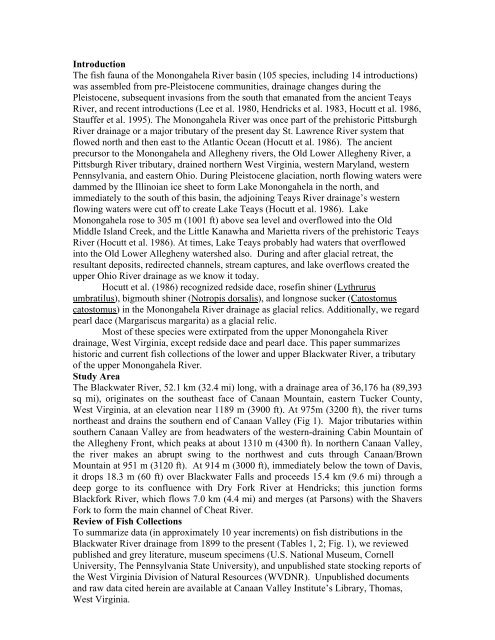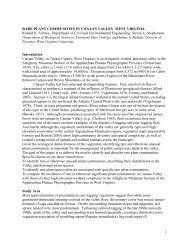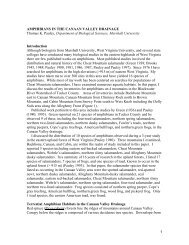FISHES OF THE BLACKWATER RIVER DRAINAGE, TUCKER ...
FISHES OF THE BLACKWATER RIVER DRAINAGE, TUCKER ...
FISHES OF THE BLACKWATER RIVER DRAINAGE, TUCKER ...
Create successful ePaper yourself
Turn your PDF publications into a flip-book with our unique Google optimized e-Paper software.
IntroductionThe fish fauna of the Monongahela River basin (105 species, including 14 introductions)was assembled from pre-Pleistocene communities, drainage changes during thePleistocene, subsequent invasions from the south that emanated from the ancient TeaysRiver, and recent introductions (Lee et al. 1980, Hendricks et al. 1983, Hocutt et al. 1986,Stauffer et al. 1995). The Monongahela River was once part of the prehistoric PittsburghRiver drainage or a major tributary of the present day St. Lawrence River system thatflowed north and then east to the Atlantic Ocean (Hocutt et al. 1986). The ancientprecursor to the Monongahela and Allegheny rivers, the Old Lower Allegheny River, aPittsburgh River tributary, drained northern West Virginia, western Maryland, westernPennsylvania, and eastern Ohio. During Pleistocene glaciation, north flowing waters weredammed by the Illinoian ice sheet to form Lake Monongahela in the north, andimmediately to the south of this basin, the adjoining Teays River drainage’s westernflowing waters were cut off to create Lake Teays (Hocutt et al. 1986). LakeMonongahela rose to 305 m (1001 ft) above sea level and overflowed into the OldMiddle Island Creek, and the Little Kanawha and Marietta rivers of the prehistoric TeaysRiver (Hocutt et al. 1986). At times, Lake Teays probably had waters that overflowedinto the Old Lower Allegheny watershed also. During and after glacial retreat, theresultant deposits, redirected channels, stream captures, and lake overflows created theupper Ohio River drainage as we know it today.Hocutt et al. (1986) recognized redside dace, rosefin shiner (Lythrurusumbratilus), bigmouth shiner (Notropis dorsalis), and longnose sucker (Catostomuscatostomus) in the Monongahela River drainage as glacial relics. Additionally, we regardpearl dace (Margariscus margarita) as a glacial relic.Most of these species were extirpated from the upper Monongahela Riverdrainage, West Virginia, except redside dace and pearl dace. This paper summarizeshistoric and current fish collections of the lower and upper Blackwater River, a tributaryof the upper Monongahela River.Study AreaThe Blackwater River, 52.1 km (32.4 mi) long, with a drainage area of 36,176 ha (89,393sq mi), originates on the southeast face of Canaan Mountain, eastern Tucker County,West Virginia, at an elevation near 1189 m (3900 ft). At 975m (3200 ft), the river turnsnortheast and drains the southern end of Canaan Valley (Fig 1). Major tributaries withinsouthern Canaan Valley are from headwaters of the western-draining Cabin Mountain ofthe Allegheny Front, which peaks at about 1310 m (4300 ft). In northern Canaan Valley,the river makes an abrupt swing to the northwest and cuts through Canaan/BrownMountain at 951 m (3120 ft). At 914 m (3000 ft), immediately below the town of Davis,it drops 18.3 m (60 ft) over Blackwater Falls and proceeds 15.4 km (9.6 mi) through adeep gorge to its confluence with Dry Fork River at Hendricks; this junction formsBlackfork River, which flows 7.0 km (4.4 mi) and merges (at Parsons) with the ShaversFork to form the main channel of Cheat River.Review of Fish CollectionsTo summarize data (in approximately 10 year increments) on fish distributions in theBlackwater River drainage from 1899 to the present (Tables 1, 2; Fig. 1), we reviewedpublished and grey literature, museum specimens (U.S. National Museum, CornellUniversity, The Pennsylvania State University), and unpublished state stocking reports ofthe West Virginia Division of Natural Resources (WVDNR). Unpublished documentsand raw data cited herein are available at Canaan Valley Institute’s Library, Thomas,West Virginia.
















